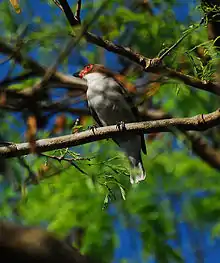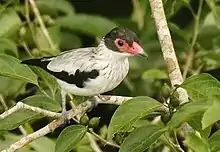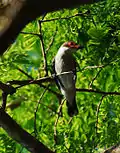Tityra
The tityras are passerine birds in the genus Tityra of the family Tityridae. They are found from southern Mexico, through Central America, to northern and central South America, including Trinidad.
| Tityra | |
|---|---|
 | |
| Masked tityra (Tityra semifasciata) | |
| Scientific classification | |
| Kingdom: | Animalia |
| Phylum: | Chordata |
| Class: | Aves |
| Order: | Passeriformes |
| Family: | Tityridae |
| Genus: | Tityra Vieillot, 1816 |
| Species | |
|
3-4, see text | |
These are medium-sized birds, typically around 20–25 centimetres (7.9–9.8 in) long, with large bills. The adult males are greyish-white above and white below, except for the wings and tail which are at least partially black. The males of all three species also have black head markings. The females are similar, but are duller, with browner or greyer head markings. The black-tailed and the masked tityra both have a conspicuous red eye-ring and base of the bill.
Behavior
These species are found in forest clearings and edges, second growth and other semi-open habitats such as plantation shade trees. The eggs are laid in a bed of dry leaves in a tree hole, often an old woodpecker nest. The female incubates alone, but both parents feed the chicks. Fledging takes up to 25 days.
Tityras are seen alone or in pairs, perched conspicuously as they feed on medium-sized fruits, large insects and sometimes small lizards. They have unmusical nasal grunting or buzzing calls.
Taxonomy
The genus Tityra was introduced by the French ornithologist Louis Jean Pierre Vieillot in 1816 with black-tailed tityra as the type species.[1] Tityra was the name of a shepherd in Virgil’s poem Eclogues.[2]
The tityras have traditionally been placed in the cotinga or the tyrant flycatcher family, but evidence strongly suggest they are better placed in Tityridae, where now placed by South American Classification Committee.[3] The black-crowned tityra is sometimes placed in a separate genus Erator.
The genus contains three species:[4]
| Image | Scientific name | Common Name | Distribution |
|---|---|---|---|
 | Tityra cayana | Black-tailed tityra | Bolivia, Argentina, Ecuador, Brazil |
 | Tityra semifasciata | Masked tityra | Mexico, through Central America, to northwestern and central South America (as far south as Paraguay). |
 | Tityra inquisitor | Black-crowned tityra | Argentina, Belize, Bolivia, Brazil, Colombia, Costa Rica, Ecuador, French Guiana, Guatemala, Guyana, Honduras, Mexico, Nicaragua, Panama, Paraguay, Peru, Suriname, Trinidad and Tobago, and Venezuela. |
Another species, the white-tailed tityra (Tityra leucura), is generally considered a variant of the black-crowned tityra, but recent evidence suggests it may be a valid species restricted to the Brazilian Amazon near the Madeira River.[5]
References
- Vieillot, Louis Jean Pierre (1816). Analyse d'une Nouvelle Ornithologie Élémentaire (in French). Paris: Deterville/self. p. 39.
- Jobling, J.A. (2018). del Hoyo, J.; Elliott, A.; Sargatal, J.; Christie, D.A.; de Juana, E. (eds.). "Key to Scientific Names in Ornithology". Handbook of the Birds of the World Alive. Lynx Edicions. Retrieved 26 June 2018.
- Prum, Rick (2007). "Proposal (313): Adopt the Family Tityridae". South American Classification Committee. Cite journal requires
|journal=(help) - Gill, Frank; Donsker, David, eds. (2018). "Cotingas, manakins, tityras, becards". World Bird List Version 8.1. International Ornithologists' Union. Retrieved 26 June 2018.
- Whittaker, Andrew (2008). "Field evidence for the validity of White-tailed Tityra Tityra leucura Pelzeln, 1868". Bulletin of the British Ornithologists' Club. 128: 107–113.
